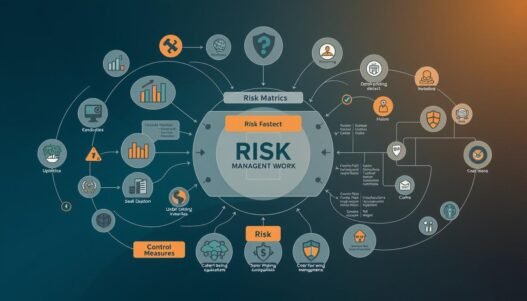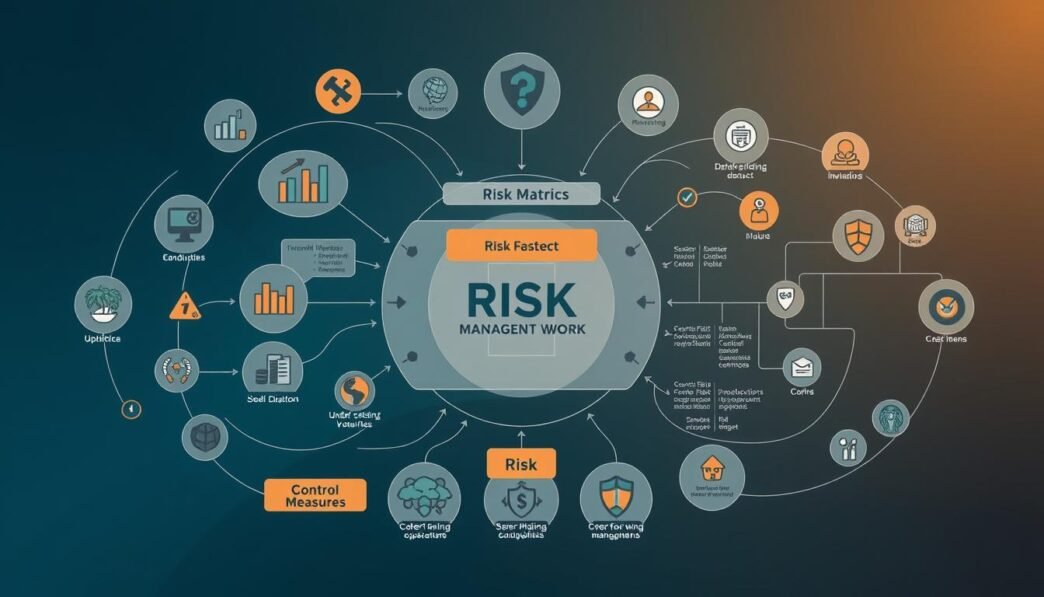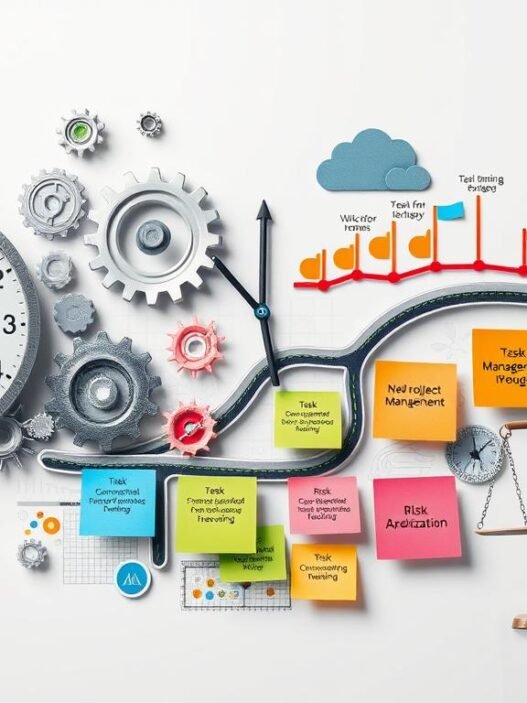Did you know that nearly 60% of organizations face big problems because of risks they didn’t see coming? This shows how important risk management is for keeping businesses strong and making smart choices. In today’s fast-changing world, knowing the basics of risk management is key for keeping businesses growing and safe. This article will cover the main ideas, steps, and future directions of risk management. It aims to help businesses protect their assets and do better.
The Tylenol crisis in 1982 is a great example. It showed how important it is to manage risks ethically. Johnson & Johnson recalled all their products after people died from tainted capsules. This move showed their strong commitment to keeping customers safe and building trust1.
As businesses deal with complex situations, they must see that good risk management is more than just about money. It’s also about being ethical and keeping customer trust1. By using risk assessment and mitigation in their daily work, companies can protect themselves and plan for the future2.
Key Takeaways
- Risk management is key for keeping businesses stable and strong.
- Good risk management helps keep customer trust and ethical standards high.
- Regularly checking and sorting risks helps make better decisions.
- The rise of digital changes means companies need better risk management plans.
- Understanding how risks are connected is vital for good risk management.
What is Risk Management?
Risk management is a key process for organizations to protect themselves from unknowns. It involves spotting, evaluating, and sorting risks, then using strategies to lessen their effects. Knowing what risk management is helps businesses stay strong and stable.
Definition and Importance
Risk management is about finding and dealing with threats like IT risks, accidents, and natural disasters. It’s a way for companies to be ready for dangers and stay stable over time. ISO 31 000 says good risk management is key for keeping organizations safe and following best practices3.
The Role of Risk Management in Organizations
Risk management is more than just following rules; it’s crucial for making smart decisions and keeping operations running smoothly. Companies that focus on risk management do better in business. A PwC study shows they are more likely to win trust from stakeholders and grow faster4.
By using these strategies, leaders can make choices that protect everyone’s interests. This is especially important when markets change and rules evolve.
Types of Risks in Business
It’s key for businesses to know about different risks to stay ahead. Each risk needs careful handling to protect assets and keep operations smooth. Here are the main risks businesses face today:
Operational Risk
Operational risk comes from internal problems like system failures or natural disasters. It also includes risks from employee actions that can stop operations. These issues can lead to big financial losses and make things less efficient5.
Financial Risk
Financial risk impacts a company’s money health. It includes risks from market changes, bad investments, and too much debt. If not managed well, it can make it hard for a company to pay its bills65.
Strategic Risk
Strategic risk comes from changes in the business world. It’s about adapting to new market trends or consumer behaviors. Being able to see these changes ahead is crucial for success7.
Compliance Risk
Compliance risk is about following laws and regulations. Not following them can lead to fines, damage to reputation, and loss of trust. Issues like workplace safety, data protection, and environmental rules are common in this area5.
Reputational Risk
Reputational risk is about how people see your company. It’s affected by things like product failures, data breaches, or bad press. Keeping a good image is important because bad reputation can hurt profits and customer loyalty5.
| Type of Risk | Description | Examples |
|---|---|---|
| Operational Risk | Risks due to internal failures or events that disrupt operations. | Cyber attacks, natural disasters, employee negligence. |
| Financial Risk | Risks affecting an organization’s financial performance. | Market fluctuations, high debt levels, investment losses. |
| Strategic Risk | Risks from poor business decisions or changes in the environment. | Market competition, consumer trend shifts. |
| Compliance Risk | Risks related to regulatory breaches. | Data protection failures, environmental violations. |
| Reputational Risk | Risks stemming from public perception. | Negative press, faulty products, service failures. |
Importance of Risk Management
Risk management is key in today’s fast-changing business world. Companies need good strategies to keep their assets safe and stable. This also helps them make better decisions.
Protecting Assets and Ensuring Stability
Risk management is about spotting, checking, and handling threats to a company’s money, profits, and work8. By keeping assets safe, companies work better and keep their stakeholders happy9. Good risk management plans figure out risks to guess their effect on a business. This lowers the chance of risks happening and lessens their impact9.
Enhancing Decision-Making
Risk management helps understand risks in a company, keeping its value high through smart choices8. It finds risks and plans how to deal with them9. Also, using new tech helps risk managers spot risks and act fast, making decisions better10.
| Aspect | Description | Example |
|---|---|---|
| Asset Protection | Identifying vulnerabilities to safeguard organizational resources. | Insurance policies, cybersecurity measures. |
| Stability Maintenance | Ensuring consistent operations to foster stakeholder confidence. | Emergency response plans, contingency frameworks. |
| Informed Decision-Making | Utilizing data and analytics for strategic choices. | Risk analysis using AI for predictive modeling. |
The Risk Management Process
The risk management process is a series of steps to help businesses handle risks. It starts with identifying risks, then assessing them, and finally, mitigating and monitoring them. Each step is crucial for a solid risk management plan. This plan helps organizations prepare for and tackle challenges.
Risk Identification
Risk identification is the first step. It’s where businesses find and list potential risks. Tools like stakeholder interviews and SWOT analysis help understand these risks. By documenting them, companies can see all the threats they face, like legal, environmental, market, and regulatory risks11.
Risk Assessment
After identifying risks, the next step is risk assessment. This is where businesses evaluate the risks’ potential impact and likelihood. They use risk matrices to rank risks by severity11. This helps them focus on the most important threats.
Risk Mitigation
After assessing risks, businesses develop strategies to mitigate them. They might avoid, transfer, or reduce risks. For example, better security can lower cyber threats12. By treating risks, businesses protect their resources and keep operations stable.
Risk Monitoring
The final step is risk monitoring. It involves watching the risk environment and checking if mitigation strategies work. Keeping risk registers up to date and talking to stakeholders is key12. This ongoing process keeps businesses ready to face new challenges.
Enterprise Risk Management (ERM)
Enterprise Risk Management (ERM) is a big change in how companies handle risks. It uses a complete and joined-up approach to risk management. The ERM overview has eight main parts, based on the COSO framework, which helps companies deal with complex risks well13. Industries like aviation, construction, and finance see the value in ERM to improve their risk management13.
Overview of ERM
ERM goes beyond old ways of managing risks. It makes sure risk decisions are made across the whole company, not just in parts. This helps companies use a clear plan to spot and check risks that could affect them a lot13. It also helps improve how companies make big decisions and understand how new risks can affect their goals14.
Benefits of an Integrated Approach
Using a joined-up risk management approach helps teams work together better. This makes sure risk management is the same everywhere in the company13. Companies with good ERM often have a Chief Risk Officer (CRO) to lead risk strategies and make sure risk management is part of planning13. ERM also helps companies come up with plans to deal with risks, like avoiding or sharing them13. This way, companies can be more resilient and flexible in a fast-changing world.
| Key Component | Functionality |
|---|---|
| Risk Identification | Recognize potential risks affecting the organization. |
| Risk Assessment | Evaluate the likelihood and impact of identified risks. |
| Risk Response | Develop strategies for mitigating or accepting risks. |
| Control Activities | Implement plans with preventative and detective controls. |
| Information Systems | Capture data to support informed risk management decisions. |
| Monitoring Mechanisms | Review ERM policies and practices consistently. |
With this framework, companies can handle changing risks better. They can make sure their efforts match their goals, giving them an edge in a tough business world14.
Creating an Effective Risk Management Plan
An effective risk management plan is key for any organization. It helps protect assets and improve performance. The process involves several steps to manage risks well.
Steps to Develop a Risk Management Plan
The first step is setting clear goals. This is important as it helps focus efforts. Next, identifying risks is done through detailed analysis.
This analysis leads to a Risk Register to handle potential risks15. Then, risks are assessed based on impact and likelihood. This helps in prioritizing risks effectively.
Creating strategies to mitigate risks is also crucial. It outlines actions to reduce harm and increase success16.
Engaging Stakeholders in the Process
Getting stakeholders involved is essential. It brings different views, making decisions better. This collaboration improves risk management efforts.
It leads to stronger outcomes and more commitment from everyone17. This teamwork helps adapt risk management plans to new challenges.

Common Risk Management Techniques
Effective risk management uses many techniques to help organizations face challenges. By using strategies like avoiding risks, keeping risks, and transferring risks, businesses can deal with financial uncertainties. This helps them stay on track with their goals.
Avoidance Strategies
Avoidance strategies mean not taking on high-risk activities. For example, a business might choose not to start a risky project. This helps prevent big problems and keeps finances safe.
Retention Methods
Risk retention means accepting some risks and knowing the possible downsides. It’s used when managing the risk is cheaper than the possible loss. For instance, small damages might be covered by a maintenance budget. This way, resources are used wisely to manage risks.
Risk Transfer through Insurance
Risk transfer moves the cost of certain risks to an insurance company. It’s great for avoiding big losses. For example, health insurance for students abroad covers unexpected medical costs. It’s also used for event risks in university facilities. This should be a last choice, after trying other methods.
| Technique | Description | Example |
|---|---|---|
| Avoidance | Eliminating risks by not engaging in high-risk activities | Not pursuing certain business ventures |
| Retention | Accepting risks and absorbing potential losses | Retaining minor property damage risks |
| Transfer | Shifting the financial burden of risks to a third party | Using insurance to cover potential losses |
Using these techniques helps organizations manage risks well. This ensures they’re ready for today’s business world. It’s key for dealing with international markets, technology, and rules.
Good risk management means knowing and using these methods. It also means doing it in a way that fits with the company’s goals. For more on risk management, check out this guide on risk management techniques1819.
Challenges in Risk Management
Companies face big challenges when dealing with risk management. It’s key to know these risks and avoid common mistakes. This helps keep businesses running smoothly.
Common Pitfalls
Many issues can harm a company’s risk management. Not spotting all risks is a big problem. Also, not seeing threats like natural disasters or political changes can cause big financial losses20.
Not getting everyone involved can make it hard to use good risk plans21. It’s also tricky to pick the right metrics to measure risks22.
Strategies to Overcome Challenges
Creating a culture of openness and learning is a good start. Training programs help employees understand and talk about risks. This is key to beating risk challenges.
Using methods like ISO 27005:2011 or scenario analysis helps with new tech and outside changes21. Focusing on the five Cs—commitment, contribution, consistency, controls, and communication—makes risk management better21.

The Future of Risk Management
The world of risk management is changing fast, thanks to digital transformation impact and cybersecurity threats. Banks are at the forefront, with 70% making digital risk management a top priority. They’re also investing heavily in digitizing their risk processes23.
Impact of Digital Transformation
Digitalization is changing how we manage risks. Computing power has grown a lot since the 1970s. This change is making technology essential for businesses to keep up23.
Companies need to look ahead and identify risks early. This way, they can prevent problems before they start24.
The Rise of Cybersecurity Threats
As we rely more on digital, cybersecurity threats grow. Today’s business world is more connected, making geopolitical risks bigger. Companies must strengthen their risk management to stay safe24.
Survey results show 70% think fintech can help digitize risk functions. This highlights the need to fight off advanced threats23.
| Statistics | Implications |
|---|---|
| 70% of banks have digital risk management in focus | Highlighting an industry shift toward digitalization in risk management. |
| 70% expect regulatory costs for risk to increase by more than 50% in five years | Indicating rising complexities and costs in risk management procedures. |
| 85% identify legacy IT as an impediment to digitizing risk | Emphasizing the need for updated technology to advance risk strategies. |
| Only about 10% of risk groups allocate more than half of their budget to digitization | Suggesting a gap in resource allocation for effective digital transformation. |
Companies must keep improving their risk management. They need to update their methods to deal with new threats and changes. By integrating risk management into their core, they can build strong frameworks for the future2425.
Conclusion
Risk management is key to a company’s strategy. It helps protect assets and makes better decisions. Knowing different risks and using good risk management strategies are crucial in today’s business world.
Experts often help with risk assessment. This shows how important it is to have a plan that fits your business needs26.
Scientific risk assessment is also vital. It makes sure risks are handled well and safely, helping consumers feel secure27. With digital changes and new threats, companies must be ready to adapt and face risks head-on.
They need to keep checking their risk plans. This helps them not just survive but also grow in a tough market.
In short, good risk practices are essential for a company’s long-term success. As risks get more complex, having a strong risk management plan is more important than ever. It’s a key part of keeping a business strong and sustainable.
















